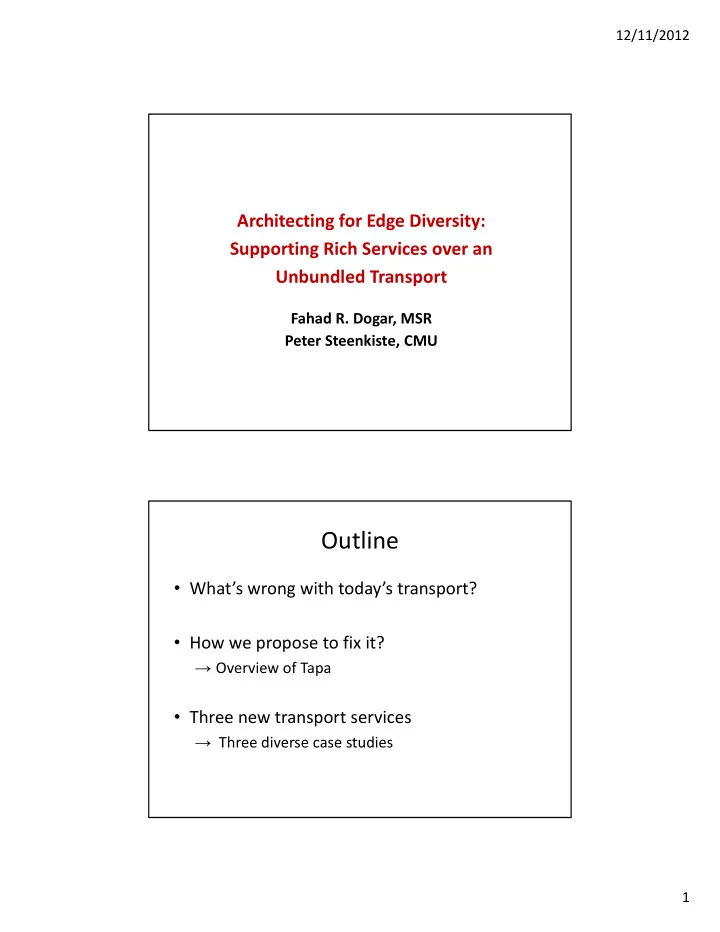

12/11/2012 Architecting for Edge Diversity: Supporting Rich Services over an Unbundled Transport Fahad R. Dogar, MSR Peter Steenkiste, CMU Outline • What’s wrong with today’s transport? • How we propose to fix it? → Overview of Tapa • Three new transport services → Three diverse case studies 1
12/11/2012 Original Internet Included fairly homogenous hosts and networks Network’s role was limited to providing “connectivity” Host ‐ based applications (e.g., telnet, ftp) 3 Today’s Internet – Diversity Everywhere Heterogeneous Rich Network Services Networks & Devices Trend towards Data oriented Apps Dealing with diversity is difficult in today’s Internet 4 2
12/11/2012 Limitations of “Ad ‐ Hoc” Solutions Example: Transparent Proxies Proxy Server Client Performance Make the Internet often inferior to Brittle and system wide Complex solutions Need to address diversity in a more systematic way 5 Systematic Support for Diversity App Semantics Services CC, Reliability, … CC, Reliability, … TAP Wireless Segment Wired Segment Wired Two Key Concepts WX Unbundling Visible in ‐ path services 6 3
12/11/2012 Tapa ‐ Architecture Synthesizes these concepts in a new transport architecture Session ‐ > specific application semantics (e.g., reliability, integrity) Xfer Layer ‐ > E2E Data Delivery Segment Layer ‐ > best effort data delivery across a segment 7 Tapa – Identifiers and Addresses • Hosts – Self ‐ Certified Identifiers (similar to AIP, XIA, etc) – Also have separate “locators” that define network attachment point – changes over time – Use existing mechanisms for routing • Data – Tapa layers work at the granularity of ADUs • Segment layer transfers segments across segment – ADUs are identified using their hash value • Facilitates use of data oriented optimizations 4
12/11/2012 Segment Layer Best effort ADU delivery over a segment Internal protocol optimized for the segment 9 Transfer Layer E2E ADU delivery & E2E Congestion Control Supports two modes: Pull – Opportunistic ADU retrieval based on its id Push – Directly send ADU to the other end ‐ point Why do we need E2E congestion control? 10 5
12/11/2012 Session Layer Support common application semantics Reliability, Confidentiality, Data Integrity, and Data Ordering Traditional E2E Semantics + New Semantics involving services 11 Tweaking Modularity TCP/IP Tapa ADUs Application Application App Semantics Session App Semantics Connection Mgt ADUs E2E ADU Xfer Xfer E2E Cong. Control TCP Congestion Ctl. Congestion Cont. Flow Control Flow Control Error Control Error Control Segment E2E Routing Forwarding IP Forwarding Routing Link Error Control Error Control Link 12 6
12/11/2012 Tapa ‐‐ Services • TAPs can support various services – E.g., Caching, Traffic Shaping, Transcoding, etc – Implemented at the transfer layer – May change session or high layer semantics • Case Studies – Catnap ‐ Traffic Shaping to Improve Energy Efficiency – Vigilante ‐ Content Distribution for OSNs – Swift ‐ Mobile and Wireless Optimizations Bandwidth Discrepancy in End ‐ to ‐ end Transfers Server Client Wireless AP 3 Mbps 40 Mbps 3-5 Mbps 54 Mbps 0.3ms Packet Transmission Time = Idle period = 3.7ms 4ms – too small for PSM • Catnap combines short idle times to save energy • TAP buffers incoming packets while client sleeps • Scheduler schedules burst transfer to maximize energy savings while avoiding increase in e ‐ e delay – Estimates bandwidth in wired and wireless segments 14 7
12/11/2012 Battery Life Improvement ‐ N810 3 hours of more 2x increase in battery life with battery life Catnap 15 Vigilante • Content Distribution for OSNs – Today’s client ‐ server design requires high cost; performance is still often poor • Idea: Use TAPs of social networking users as opportunistic caches – Downloading from nearby friends can reduce latency – Reduces burden on the server 8
12/11/2012 Bob Vigilante App App Req Caching Service get ADU App App Meta ‐ Data Bob’s TAP Sends Meta ‐ Data put to Server ADU ADU ADU Slow Segment Alice Alice’s for Background xfers Home Server TAP Can get data from TAPs of Alice and Bob More Intelligence at the TAPs 1)Pre ‐ loading Other TAPs Julie 2) Implement Server Side functions 17 Vigilante Performance Vigilante can outperform even the best case performance of a centralized system 18 9
12/11/2012 Swift – Optimizations for Mobile Users TCP – 3G Segment TAP (ATT) HOP Segment TAP (CMU) TAP (Starbucks) WiFi Segment HOP is a transport protocol for wireless mesh networks [NSDI 2009] 19 Swift in vehicular settings Using multiple segments helps in masking disruptions 10
12/11/2012 Tapa and the eXpressive Internet Architecture • XIA offers native support for communication with content and services, besides hosts • Tapa transport architecture carries over naturally • Tapa content support can be Application Tapa pushed “into the network” Presentation – XIA does caching of chunks Session (ADUs) based on content IDs Transport XIA • Applications can use service Network Data link IDs for edge services Physical 21 Related Work • Lots of work on middleboxes – Mostly focus on hidden middleboxes – Flow versus network layer visible middleboxes • Unbundling of the transport for middleboxes – Tapa more general and operates at ADU level • Overlays: Tapa has constrained but dynamic topology, network diversity, … • DTN: Tapa has more constrained topologies, but supports push/pull and service insertion • Shares features with some future internet proposals 11
12/11/2012 Why should I read the paper? • Prototype Implementation and Evaluation • How we ported a legacy application (Firefox)? • Use of various segment protocols – Porting existing ones (e.g., HOP) – new protocols (UDP ‐ Blast, a Lightweight UDP based protocol for WiFi) Summary • Increasing diversity calls for rethinking today’s transport architecture – Really about rethinking how to modularize • Tapa synthesizes two concepts: Unbundling and visible services • Three diverse case studies demonstrate the flexibility and performance of Tapa 12
Recommend
More recommend